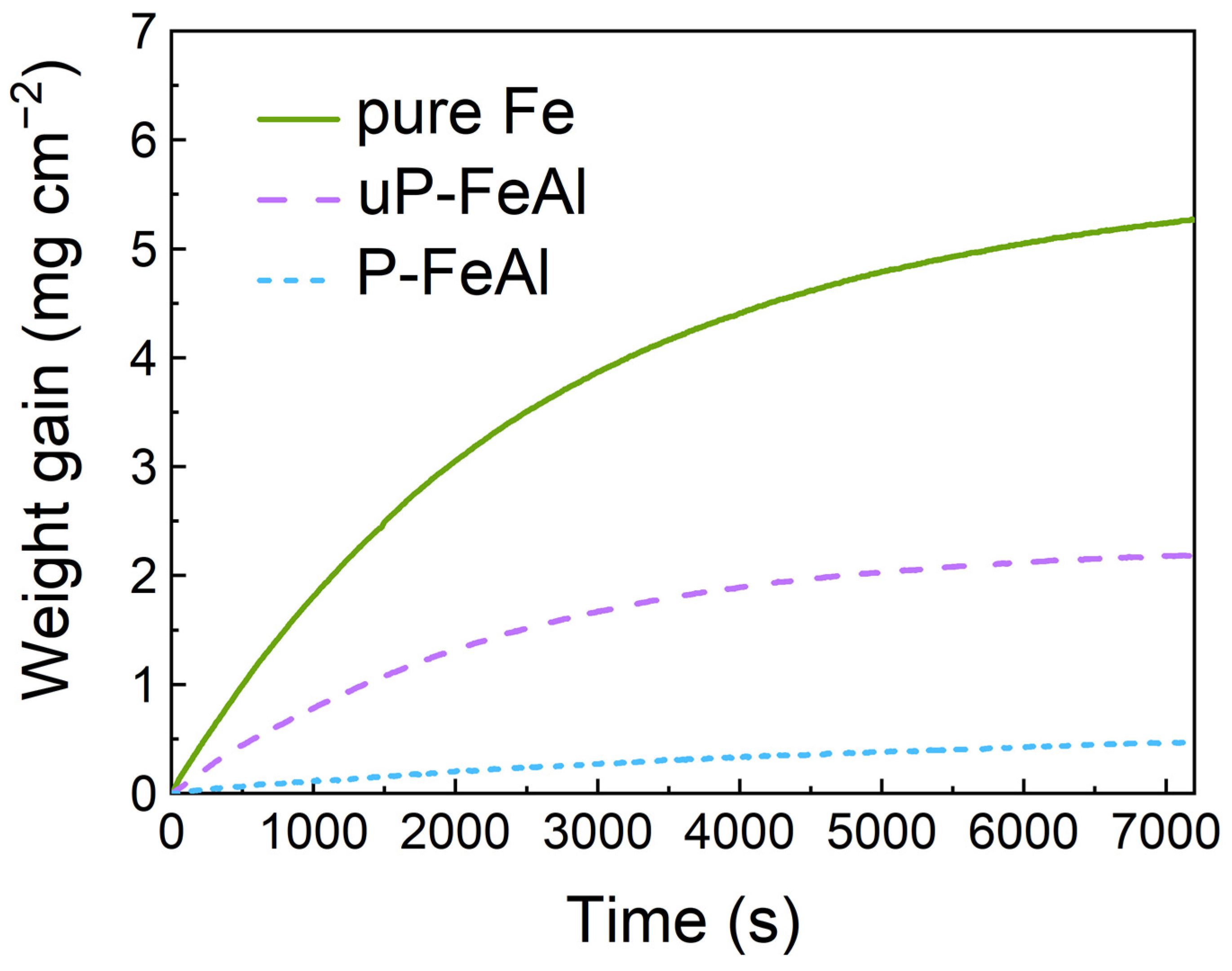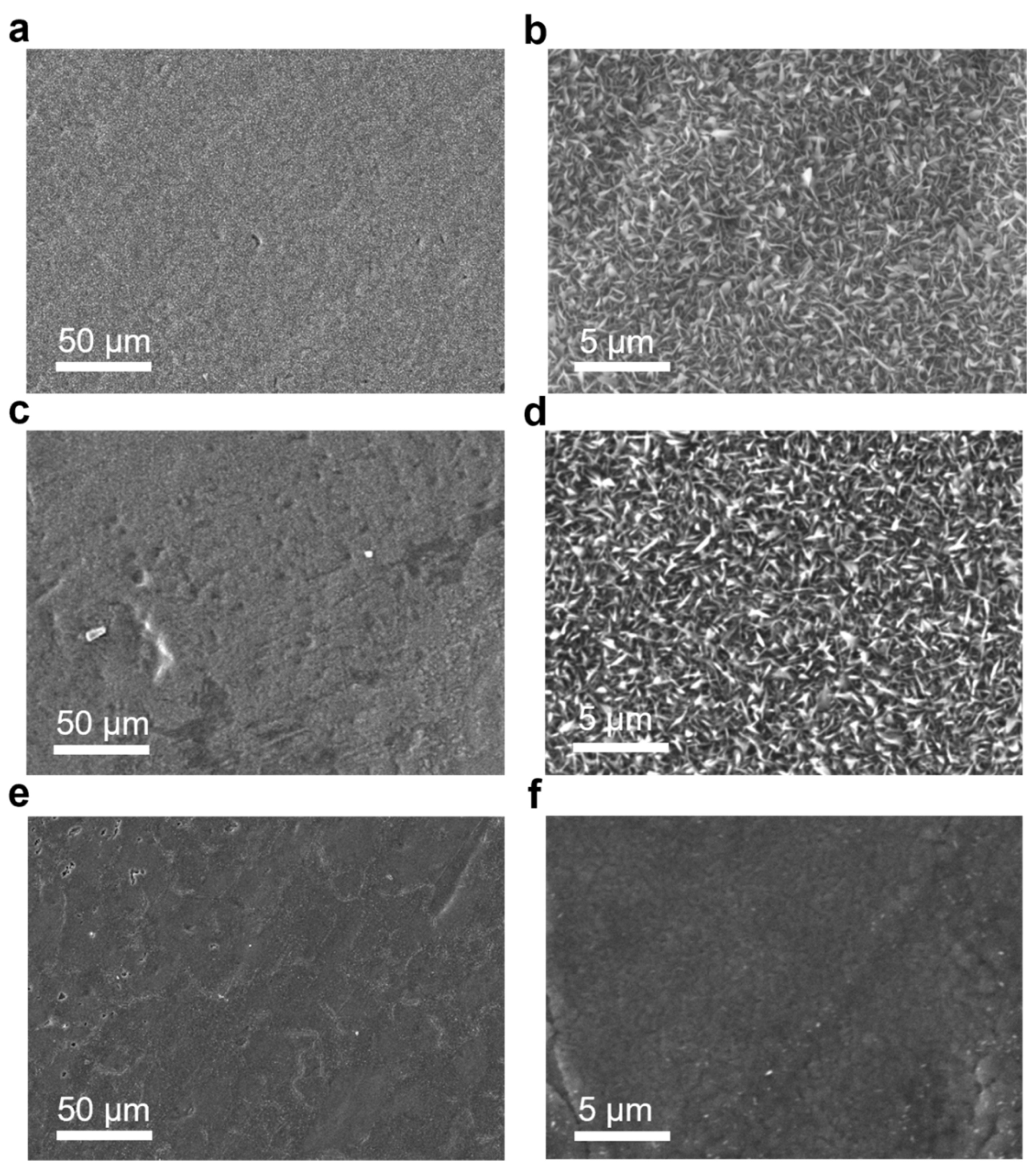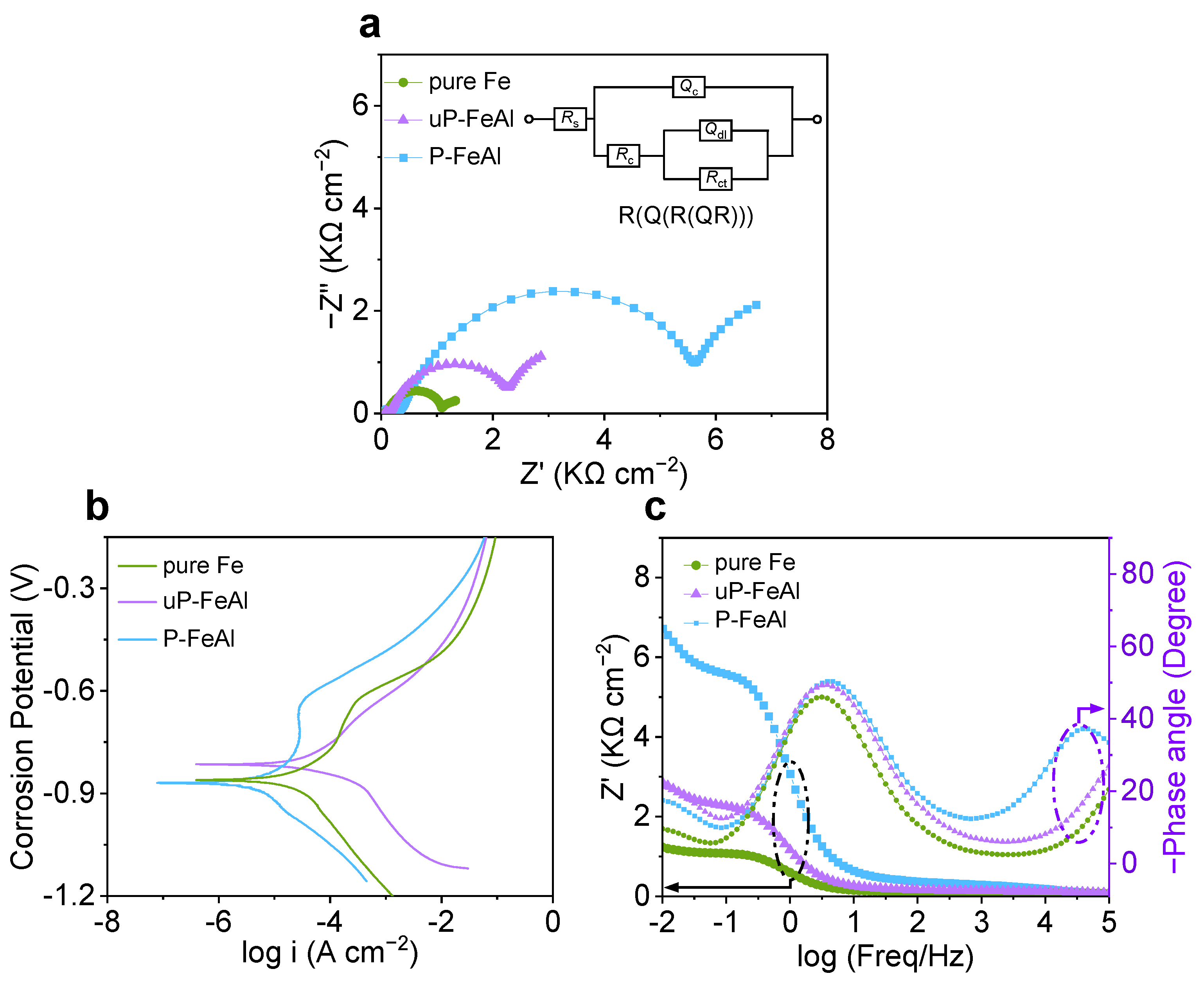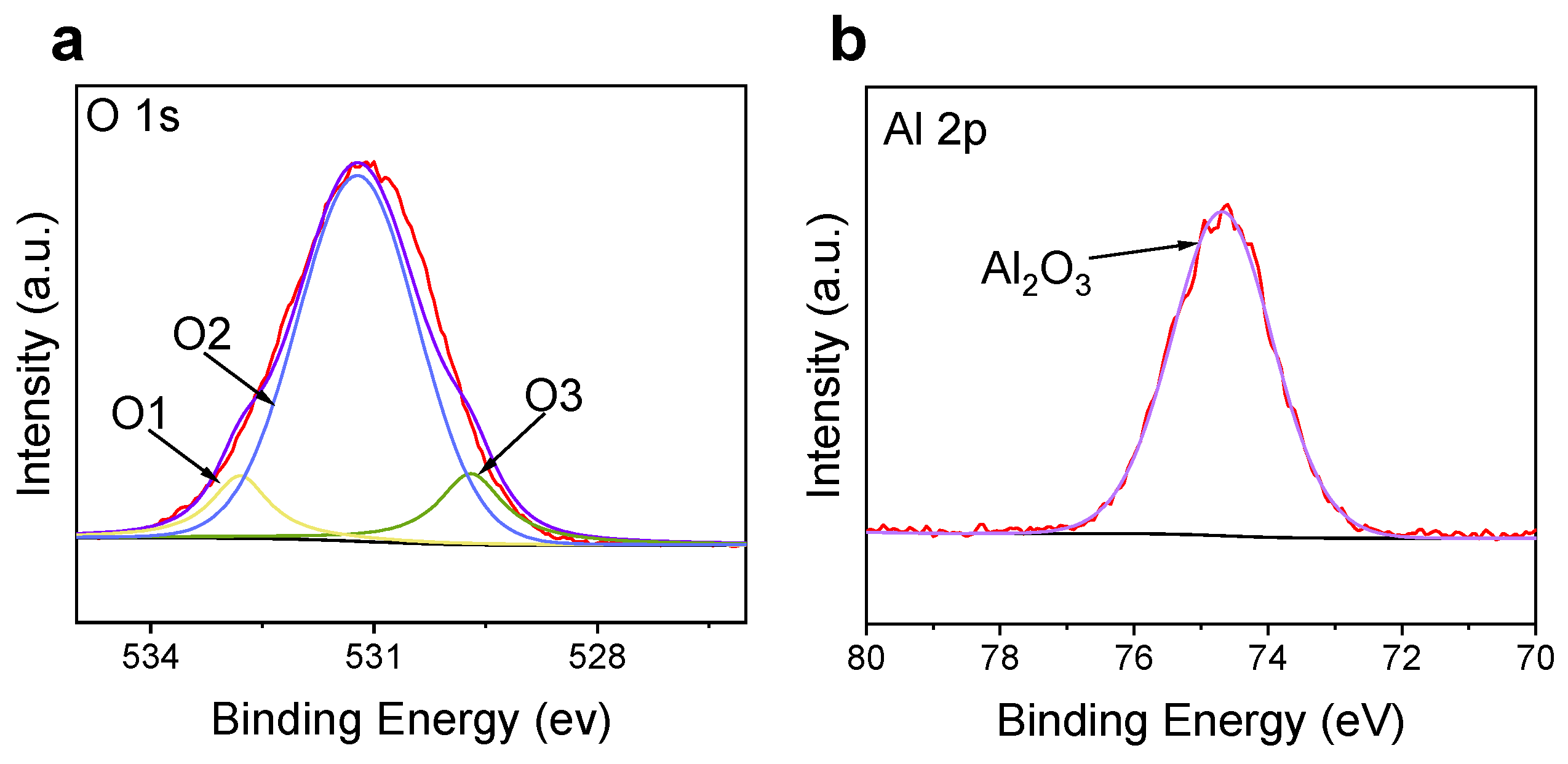Formation of Nanoscale Al2O3 Protective Layer by Preheating Treatment for Improving Corrosion Resistance of Dilute Fe-Al Alloys
Abstract
:1. Introduction
2. Materials and Experimental Procedures
3. Results and Discussion
4. Conclusions
Author Contributions
Funding
Institutional Review Board Statement
Informed Consent Statement
Data Availability Statement
Acknowledgments
Conflicts of Interest
References
- Qiao, Y.X.; Wang, X.Y.; Yang, L.L.; Wang, X.J.; Chen, J.; Wang, Z.B.; Zhou, H.L.; Zou, J.S.; Wang, F.H. Effect of aging treatment on microstructure and corrosion behavior of a Fe-18Cr-15Mn-0.66N stainless steel. J. Mater. Sci. Technol. 2022, 107, 197–206. [Google Scholar] [CrossRef]
- Liu, M.; Li, J.; Zhang, Y.X.; Xue, Y.N. Recent Advances in Corrosion Research of Biomedical NiTi Shape Memory Alloy. Rare Metal Mat. Eng. 2021, 50, 4165–4173. [Google Scholar]
- Raman, R.K.S. Mechanical Alloying of Elemental Powders into Nanocrystalline (NC) Fe-Cr Alloys: Remarkable Oxidation Resistance of NC Alloys. Metals 2021, 11, 695. [Google Scholar] [CrossRef]
- Backman, D.G.; Williams, J.C. Advanced materials for aircraft engine applications. Science 1992, 255, 1082–1087. [Google Scholar] [CrossRef] [PubMed]
- Aye, K.K.; Nguyen, T.D.; Zhang, J.; Young, D.J. Effect of silicon on corrosion of Fe-20Cr and Fe-20Cr-20Ni alloys in wet CO2 with and without HCl at 650 °C. Corros. Sci. 2021, 179, 109096. [Google Scholar] [CrossRef]
- Liu, M. Finite element analysis of pitting corrosion on mechanical behavior of E690 steel panel. Anti-Corros. Method M. 2022, 69, 351–361. [Google Scholar] [CrossRef]
- Gong, Y.; Young, D.J.; Kontis, P.; Chiu, Y.L.; Larsson, H.; Shin, A.; Pearson, J.M.; Moody, M.P.; Reed, R.C. On the breakaway oxidation of Fe9Cr1Mo steel in high pressure CO2. Acta Mater. 2017, 130, 361–374. [Google Scholar] [CrossRef]
- Liu, M. Effect of uniform corrosion on mechanical behavior of E690 high-strength steel lattice corrugated panel in marine environment: A finite element analysis. Mater. Res. Express 2021, 8, 066510. [Google Scholar] [CrossRef]
- Wang, F.; Shu, Y. Influence of Cr content on the corrosion of Fe-Cr alloys: The synergistic effect of NaCl and water vapor. Oxid. Met. 2003, 59, 201–214. [Google Scholar] [CrossRef]
- Jung, K.; Ahn, S.; Kim, Y.; Oh, S.; Ryu, W.H.; Kwon, H. Alloy design employing high Cr concentrations for Mo-free stainless steels with enhanced corrosion resistance. Corros Sci. 2018, 140, 61–72. [Google Scholar] [CrossRef]
- Huang, C.A.; Chang, J.H.; Chen, C.Y.; Liao, K.Y.; Mayer, J. Microstructure and electrochemical corrosion behavior of Cr-Ni-Fe alloy deposits electroplated in the presence of trivalent Cr ions. Thin Solid Films 2013, 544, 69–73. [Google Scholar] [CrossRef]
- Choi, Y.I.; Shin, E.S.; Kuroda, K.; Okido, M.; Park, C.J. Improved surface morphology and corrosion resistance for galvannealed coatings by pre-electroplating iron. Corros. Sci. 2012, 58, 152–158. [Google Scholar] [CrossRef]
- Hu, W.B.; Cai, H.L.; Yang, M.H.; Tong, X.L.; Zhou, C.M.; Chen, W. Fe-C-coated fibre Bragg grating sensor for steel corrosion monitoring. Corros Sci. 2011, 53, 1933–1938. [Google Scholar] [CrossRef]
- Kim, J.H.; Lee, M.H. A Study on Cavitation Erosion and Corrosion Behavior of Al-, Zn-, Cu-, and Fe-Based Coatings Prepared by Arc Spraying. J. Therm. Spray Technol. 2010, 19, 1224–1230. [Google Scholar] [CrossRef]
- Jeong, Y.S.; Kainuma, S.; Ahn, J.H. Structural response of orthotropic bridge deck depending on the corroded deck surface. Constr. Build Mater. 2013, 43, 87–97. [Google Scholar] [CrossRef]
- Yu, C.; Nguyen, T.D.; Zhang, J.; Young, D.J. Sulfur Effect on Corrosion Behavior of Fe-20Cr-(Mn, Si) and Fe-20Ni-20Cr-(Mn, Si) in CO2-H2O at 650 °C. J. Electrochem. Soc. 2015, 163, C106–C115. [Google Scholar] [CrossRef]
- Rao, V.S. The influence of temperature on the oxidation behaviour of Fe3AI-Fe3AlC0.69 and FeAl-Fe3AlC0.69 intermetallics. Intermetallics 2003, 11, 713–719. [Google Scholar] [CrossRef]
- Wei, W.; Geng, S.J.; Chen, G.; Wang, F.H. Growth mechanism of surface scales on Ni-Fe-Cr alloys at 960 degrees C in air. Corros. Sci. 2020, 173, 108737. [Google Scholar] [CrossRef]
- Zhang, C.-H.; Huang, S.; Shen, J.; Chen, N.-X. Structural and mechanical properties of Fe–Al compounds: An atomistic study by EAM simulation. Intermetallics 2014, 52, 86–91. [Google Scholar] [CrossRef]
- Hong, S.H.; Zhu, Y.F.; Mimura, K.; Isshiki, M. Role of Al2O3 layer in oxidation resistance of Cu-Al dilute alloys pre-annealed in H2 atmospheres. Corros. Sci. 2006, 48, 3692–3702. [Google Scholar] [CrossRef]
- Novak, P.; Nova, K. Oxidation Behavior of Fe-Al, Fe-Si and Fe-Al-Si Intermetallics. Materials 2019, 12, 1748. [Google Scholar] [CrossRef] [PubMed]
- Jang, P.; Shin, S.; Jung, C.S.; Kim, K.H.; Seomoon, K. Fabrication of Fe-Al nanoparticles by selective oxidation of Fe-Al thin films. Nanoscale Res. Lett. 2013, 8, 1–6. [Google Scholar] [CrossRef] [PubMed] [Green Version]
- Li, H.; Zhang, J.Q.; Young, D.J. Oxidation of Fe-Si, Fe-Al and Fe-Si-Al alloys in CO2-H2O gas at 800 degrees C. Corros. Sci. 2012, 54, 127–138. [Google Scholar] [CrossRef]
- Xu, Y.F.; Jeurgens, L.P.H.; Bo, H.; Lin, L.C.; Zhu, S.L.; Huang, Y.; Liu, Y.C.; Qiao, J.W.; Wang, Z.M. On the competition between synchronous oxidation and preferential oxidation in Cu-Zr-Al metallic glasses. Corros. Sci. 2020, 177, 108996. [Google Scholar] [CrossRef]
- Pang, X.J.; Li, S.S.; Qin, L.; Pei, Y.L.; Gong, S.K. Effect of trace Ce on high-temperature oxidation behavior of an Al-Si-coated Ni-based single crystal superalloz. J. IronSteel Res. Int. 2019, 26, 78–83. [Google Scholar]
- Wang, X.H.; Li, F.Z.; Chen, J.X.; Zhou, Y.C. Insights into high temperature oxidation of Al2O3-forming Ti3AlC2. Corros Sci. 2012, 58, 95–103. [Google Scholar] [CrossRef]
- Lu, S.D.; Li, X.X.; Liang, X.Y.; Shao, W.T.; Yang, W.; Chen, J. Effect of Al content on the oxidation behavior of refractory high-entropy alloy AlMo0.5NbTa0.5TiZr at elevated temperatures. Int. J. Refract Met. H. 2022, 105, 105812. [Google Scholar] [CrossRef]
- Zhu, Y.F.; Mimura, K.; Isshiki, M. Oxidation mechanism of copper at 623–1073 K. Mater. Trans. 2002, 43, 2173–2176. [Google Scholar] [CrossRef] [Green Version]
- Ogbuji, L.U. The oxidation behavior of an ODS copper alloy Cu-Al2O3. Oxid. Met. 2004, 62, 141–151. [Google Scholar] [CrossRef]
- Liu, Y.X.; Yin, F.C.; Hu, J.X.; Li, Z.; Cheng, S.H. Phase equilibria of Al-Fe-Sn ternary system. T Nonferr. Metal. Soc. 2018, 28, 282–289. [Google Scholar] [CrossRef]
- Li, R.; Wang, S.; Zhou, D.; Pu, J.; Yu, M.; Guo, W. A new insight into the NaCl-induced hot corrosion mechanism of TiN coatings at 500 °C. Corros. Sci. 2020, 174, 108794. [Google Scholar] [CrossRef]
- Dafali, A.; Hammouti, B.; Mokhlisse, R.; Kertit, S. Substituted uracils as corrosion inhibitors for copper in 3% NaCl solution. Corros. Sci. 2003, 45, 1619–1630. [Google Scholar] [CrossRef]
- Ozcan, M.; Dehri, I.; Erbil, M. Organic sulphur-containing compounds as corrosion inhibitors for mild steel in acidic media: Correlation between inhibition efficiency and chemical structure. Appl. Surf. Sci. 2004, 236, 155–164. [Google Scholar] [CrossRef]
- Saha, S.K.; Banerjee, P. Introduction of newly synthesized Schiff base molecules as efficient corrosion inhibitors for mild steel in 1 M HCl medium: An experimental, density functional theory and molecular dynamics simulation study. Mater. Chem. Front. 2018, 2, 1674–1691. [Google Scholar] [CrossRef]
- Solmaz, R.; Kardas, G.; Culha, M.; Yazici, B.; Erbil, M. Investigation of adsorption and inhibitive effect of 2-mercaptothiazoline on corrosion of mild steel in hydrochloric acid media. Electrochim. Acta 2008, 53, 5941–5952. [Google Scholar] [CrossRef]
- Saha, S.K.; Dutta, A.; Ghosh, P.; Sukul, D.; Banerjee, P. Novel Schiff-base molecules as efficient corrosion inhibitors for mild steel surface in 1 M HCl medium: Experimental and theoretical approach, Phys. Chem. Chem. Phys. 2016, 18, 17898–17911. [Google Scholar] [CrossRef]
- Visser, P.; Terryn, H.; Mol, J.M.C. On the importance of irreversibility of corrosion inhibitors for active coating protection of AA2024-T3. Corros. Sci. 2018, 140, 272–285. [Google Scholar] [CrossRef]
- Xu, J.; Zhou, C.; Chen, Z.; Wang, Y.; Jiang, S. Corrosion behaviors of (Cr,Fe)3Si/Cr13Fe5Si2 composite coating under condition of synergistic effects of electrochemical corrosion and mechanical erosion. J. Alloys Compd. 2010, 496, 429–432. [Google Scholar] [CrossRef]
- Zhu, X.X.; Sun, M.Y.; Zhao, R.; Li, Y.Q.; Zhang, B.; Zhang, Y.L.; Lang, X.Y.; Zhu, Y.F.; Jiang, Q. 3D hierarchical self-supported NiO/Co3O4@C/CoS2 nanocomposites as electrode materials for high-performance supercapacitors. Nanoscale Adv. 2020, 2, 2785–2791. [Google Scholar] [CrossRef]
- van den Brand, J.; Sloof, W.G.; Terryn, H.; de Wit, J.H.W. Correlation between hydroxyl fraction and O/Al atomic ratio as determined from XPS spectra of aluminium oxide layers. Surf. Interface Anal. 2004, 36, 81–88. [Google Scholar] [CrossRef]






Publisher’s Note: MDPI stays neutral with regard to jurisdictional claims in published maps and institutional affiliations. |
© 2022 by the authors. Licensee MDPI, Basel, Switzerland. This article is an open access article distributed under the terms and conditions of the Creative Commons Attribution (CC BY) license (https://creativecommons.org/licenses/by/4.0/).
Share and Cite
Li, C.; Freiberg, K.; Tang, Y.; Lippmann, S.; Zhu, Y. Formation of Nanoscale Al2O3 Protective Layer by Preheating Treatment for Improving Corrosion Resistance of Dilute Fe-Al Alloys. Materials 2022, 15, 7978. https://doi.org/10.3390/ma15227978
Li C, Freiberg K, Tang Y, Lippmann S, Zhu Y. Formation of Nanoscale Al2O3 Protective Layer by Preheating Treatment for Improving Corrosion Resistance of Dilute Fe-Al Alloys. Materials. 2022; 15(22):7978. https://doi.org/10.3390/ma15227978
Chicago/Turabian StyleLi, Chenglong, Katharina Freiberg, Yuntong Tang, Stephanie Lippmann, and Yongfu Zhu. 2022. "Formation of Nanoscale Al2O3 Protective Layer by Preheating Treatment for Improving Corrosion Resistance of Dilute Fe-Al Alloys" Materials 15, no. 22: 7978. https://doi.org/10.3390/ma15227978




